|
[Front Page] [Features] [Departments] [SGAP Home Page] [Subscribe]

Correas and Birds
Judy Smith
Correa is a truly Australian genus. In all there are only eleven species, all of which are endemic to Australia. Only the Common Correa (C.reflexa) grows outside of the eastern states...it also occurs in Western Australia.
Within each species of Correa there can be wide variation. Whereas my C.reflexa may have dull green flowers, yours might have flowers of a lovely pale pink colour or of scarlet tipped with green.
The correas belong to the family Rutaceae, as do the boronias, eriostemons, croweas, phebaliums and even citrus trees. They are generally recognised by their rather distinctive flowers. Apart from the White Correa (C.alba), the flowers are longish, cylindrical tubes, spreading at the top as the flowers open. These tubes are formed from four cohering petals. The calyx is cup-shaped and retained for the life of the flower (ie.it is not deciduous). Up to eight seeds may be formed in each flower and, at maturity, the fruit bursts open, releasing these seeds. The correa plants are often quite hairy, particularly the young growth, and the hairs are often rusty coloured.
Many of the correas flower over the winter months and their flowers can provide an important source of nectar to birds at this time.
Four Commonly-grown Species
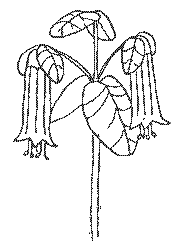 | Correa reflexa (Common Correa). This species occurs in various soils from the coast to sub-alpine areas and in vegetation types as varied as forests, scrubs and heaths. The species flowers from may to October and is generally a shrub 1 - 2 metres high. The corolla colours may be green, crimson or pink. |
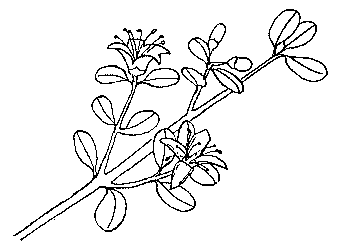 | Correa alba (White Correa or Cape Barren Tea). This is an unusual species in that it lacks the typical fused corolla. It occurs on coastal and sand dunes and rocky sea cliffs. It is a dense shrub to 1 metre and its leaves are particularly aromatic when crushed. The leaves were once used as a tea substitute, particularly by sealers on islands in Bass Strait. C.alba flowers for most of the year, but especially from June to October. |
|
| "The leaves were once used as a tea substitute, particularly by sealers on islands in Bass Strait" |
|
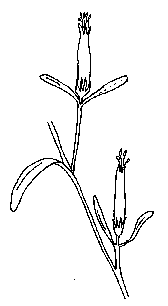 | Correa decumbens. This Correa also does not conform to rules. In this case the corolla is bell-shaped but, rather than hanging down, it faces upward. It grows as a ground cover of height about 30cm with a 3 metre spread. Flowers are red with yellow tips and occur for most of the year with a winter peak. It grows well in cold areas. |
 | Correa bauerlenii (Chef's Cap Correa). The rather unusual shape of the calyx gives rise to the common name of "Chef's Cap". Flowers are greenish and leaves are glossy and dark. It grows to a rounded plant 1.5 x 1.5 metres. This is one of three correas on the official list of Rare or Threatened Australian Plants. The Chef's Cap correa occurs only in two areas in New South Wales (near Batemans Bay and around Mimosa Rocks National Park). It is classified as "vulnerable", a fairly high classification. Two South Australian species are also classified; C.calycina is classified as "vulnerable' and C.decumbens is classified as "rare". |
The Regular Visitors
At first glance it would seem that only birds with long bills, such as Eastern Spinebills, could reap the rewards of correas' nectar. The spinebills do, in fact, make good use of the correas. Around Bega, on the NSW south coast, we recorded a large number of observations of spinebills feeding. In 9% of these observations the spinebills were at correa flowers, both C.reflexa and C.bauerlenii.
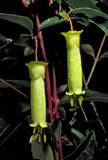
The unusual calyx on the flower of Correa bauerlenii has given rise to the common name of "Chef's Cap Correa". Select the thumbnail image or plant name for a higher resolution image (27k).
However, the other birds are not baffled by the correas. Jo Walker, Queanbeyan, has noted "I have several species of Correa in my garden, and for the last four or five years they
have been regularly visited by an Eastern Spinebill which feeds on the nectar during autumn
and winter flowering - it seems particularly attracted to C.backhousiana and to a lesser
extent to C. "Mannii" and C.reflexa. Three Crimson Rosellas - "regulars" for most of the year - are also attracted to C. "Mannii" but feed rather more destructively as they pull the flowers off and nibble them, presumably for the nectar."
Richard Loyn, in "Birds of Mountain Ash Forest", "Emu", Vol.85, Pt.4, Dec 1985, makes
some notes on birds and the Mountain Correa (C.lawrenciana). The Mountain Correa occurs in the dense understorey of tall forests on moist sheltered slopes in New South Wales and Victoria. It usually grows to 1-3 metres in height but under very favourable conditions may reach 6 metres. Flowers are usually cream or green but around the sub-alpine areas of the Snowy Mountains a lovely red flowering population occurs. It does well in cold areas.
Richard Loyn notes "ln Winter, the main food source for honeyeaters at Toolangi was the blossom of the Mountain Correa. Eastern Spinebills and Crescent Honeyeaters inserted their long bills, while White-eared Honeyeaters used their long tongues and short-billed Brown-headed Honeyeaters pecked slits in the bases of the flowers to obtain nectar. Occasionally White-naped Honeyeaters accompanied the Brown-headed, feeding in similar
fashion. Striated Thornbills and occasionally Brown Thornbills also obtained nectar from the
bases of the flowers using existing slits, including those made by Brown-headed Honeyeaters. At Cambarvale there was no Correa and Eastern Spinebills were absent. However, an alternative food was provided for Crescent and White-eared Honeyeaters by exudates from the bark of Silver Wattles."
Usually correas like well drained soil. As most grow naturally as part of the understorey
they should not object to some shade. Correa reflexa is perhaps the most reliable in a very sunny situation. C.reflexa is said to be very hardy but from my own experience they are not immune to total neglect.
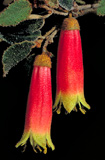
Correa reflexa is the most common species in cultivation and the most widespread in nature. Many different forms (both flower colour and plant habit) occur. Select the thumbnail image or plant name for a higher resolution image (27k).

Correa pulchella is beautiful small shrub which is best in areas not receiving significant summer rainfall. The prostrate form, shown here, is particularly attractive. Select the thumbnail image or plant name for a higher resolution image (33k).
Propagation is not difficult from cuttings. As there is great variation within populations,
propagation from cuttings is more reliable than from seeds. Some say that C.pulchella, the Beautiful Correa, is the pick of all the correas. It is a small shrub to 50cm with orange to pink coloured flowers. There are several cultivars of this Correa available, including C."Mannii".
Reproduced from the May 1986 issue of the newsletter of the Birds and Native Plants Study Group (now the Wildlife and Native Plants Study Group). At the time, Judy was the leader of the Study Group
 [Front Page] [Features] [Departments] [SGAP Home Page] [Subscribe]
[Front Page] [Features] [Departments] [SGAP Home Page] [Subscribe]
Australian Plants online - December 1996
The Society for Growing Australian Plants
E-mail: sgap@ozemail.com.au
|